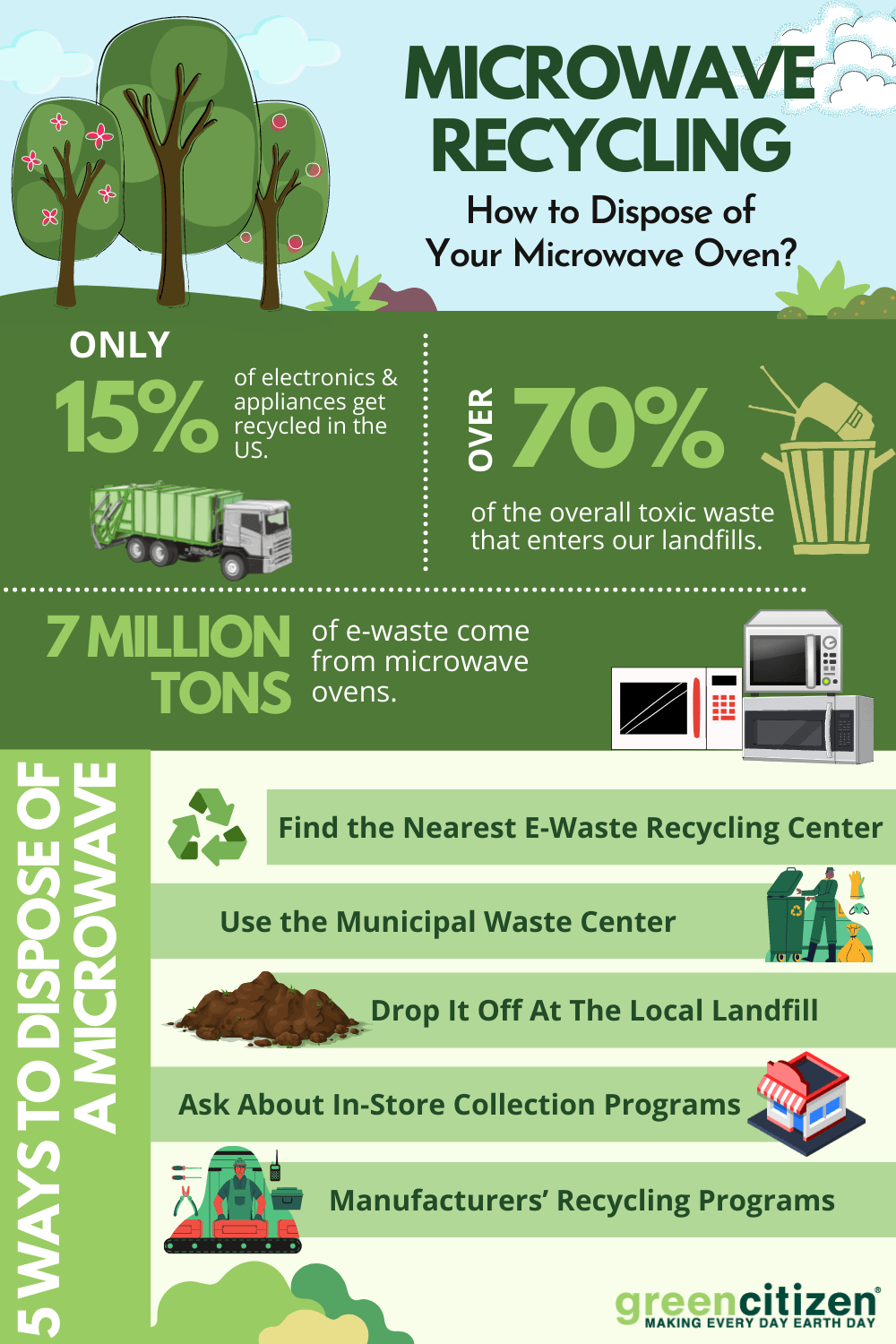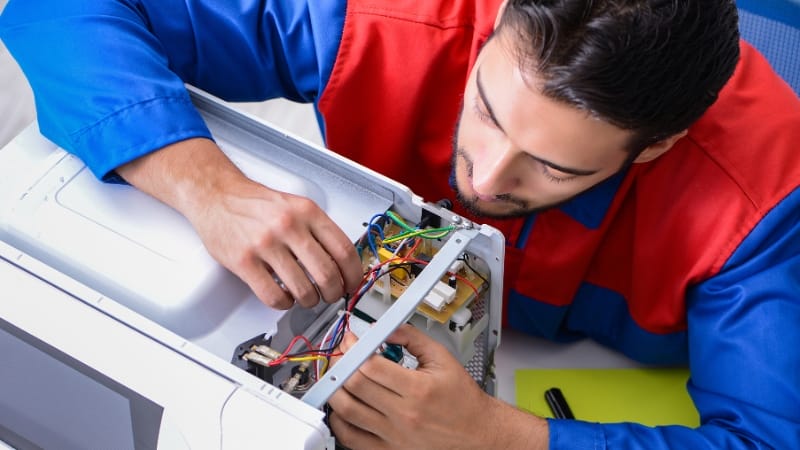Although e-waste represents only 2% of America’s trash, it makes up 70% of the overall toxic waste that enters our landfills. Now, think about this – only a slim 15% of our appliances ever get recycled.
Every year, us Americans are tossing away close to 6.9 million tons of metals, glass, and valuable materials. By 2030, we’ll produce 81.6 million tons of e-waste globally.
This needs to change fast!
Let’s start with recycling microwaves — almost every household has at least one, and we buy new models every five years. Unfortunately, many don’t know that you can recycle microwaves quite easily.
It’s high time we got serious about finding and supporting efficient microwave recycling solutions.
So, before you think about tossing your old microwave, follow the recycling guidelines in this blog.
Key Takeaway: How to Dispose of a Microwave the Right Way
Wondering how to dispose of a microwave oven? Here’s the quick guide:
- Recycle it at a certified e-waste recycling center — the most eco-friendly option.
- Use a take-back program at retailers like Best Buy or Lowe’s (usually with a new purchase).
- Mail it in through GreenCitizen’s nationwide microwave recycling service.
- Check with your local landfill or trash pickup service — but laws vary, and it’s not always allowed.
- Donate it if it still works — try thrift stores, Freecycle, or local charities.
- Contact the manufacturer — some brands offer free mail-back recycling.
Avoid dumping your microwave in the trash — it’s wasteful and may be illegal in your area. Recycling is the smart move.
Can You Recycle a Microwave Oven? (What You Need to Know)
Yes — you can recycle a microwave! In fact, microwave ovens are full of recyclable materials like steel, copper wiring, circuit boards, and even glass.
Most e-waste recycling centers and municipal drop-off programs accept microwaves for responsible disposal. Some electronics stores and appliance retailers also offer take-back programs for small appliances.
If your microwave still works, consider donating it to a local shelter or thrift store. Reuse is always better than recycling.
⚠️ Don’t toss it in the regular trash. Microwaves may contain hazardous components like capacitors and magnetrons, which can leak toxic substances into the soil or water if landfilled.
By choosing microwave recycling, you help recover valuable materials and keep harmful waste out of the environment.
How to Dispose of a Microwave Oven?
Now, we’ll go over the six most popular ways on how to dispose of a microwave oven.

1. Recycle Your Microwave at a Certified E-Waste Center
This is the most eco-friendly and responsible way to dispose of your old microwave oven.
Microwaves are considered electronic waste and contain valuable components like metal, glass, and plastic — but also parts that can harm the environment if not handled properly. That’s why you can’t just toss a microwave in your curbside recycling bin like paper or bottles.
Instead, take it to a certified e-waste recycling center. These facilities have trained professionals who safely dismantle appliances, recover reusable materials, and ensure safe microwave disposal in line with local e-waste regulations.
Not Sure Where to Go? Use the Green Directory
If you’re asking, “Where can I recycle a microwave near me?” — our Green Directory makes it easy:
- Search: Type “microwaves” into the search bar and select the suggested category.
- Enter ZIP Code: Add your ZIP or use “current location” for automatic detection.
- Choose a Recycler: View a list of microwave recycling centers within 10 miles. You can expand the radius if needed.
No center nearby? No problem. GreenCitizen offers a mail-in microwave recycling service. Just ship your old microwave to us — it’s affordable, safe, and hassle-free.
Recycling is always better than dumping. In some areas, throwing microwaves in the trash may even lead to fines.
2. Use Municipal Waste Services (But Check the Rules First)
Leaving your old microwave at the curb might seem like the easiest option — but don’t do it just yet.
Disposal laws for small appliances like microwaves vary by state and city. In many areas, putting a microwave in the trash is illegal, especially where it’s classified as e-waste. You could even face fines for improper disposal.
📍 For example, California requires microwaves to be recycled through a certified e-waste center or a retailer’s take-back program.
Even if it’s technically allowed in your area, tossing your microwave into the landfill isn’t exactly planet-friendly. Microwaves contain components that won’t break down easily — and might release toxins over time.
If you’re considering curbside pickup or a municipal waste center:
- Call your local waste service first to ask if they accept microwaves.
- Ask about bulk pickup days or designated appliance collection.
Still, recycling remains the better choice — for the environment and your conscience.
3. Drop It Off at Your Local Garbage Center or Landfill
If you’re thinking of doing it the Homer Simpson way and giving your old microwave “back to the Earth,” pump the brakes.
Some landfills and local garbage centers do accept small appliances like microwaves. They often have designated bins for e-waste or electronic items, and you might be able to skip pickup fees by dropping it off yourself.
Before you go, call ahead and ask:
- Do they accept microwave ovens or other small appliances?
- Are there fees or appointment requirements?
- Is there a separate area for electronics or household hazardous waste?
🚫 That said, landfilling your microwave should be the absolute last resort. Microwaves aren’t biodegradable and can take hundreds of years to break down. Worse, some internal parts — like capacitors — may release harmful substances over time, adding to the broader issue of hazardous waste pollution.
If you’re in the San Francisco Bay Area, bring your old microwave to GreenCitizen’s Recycling Drop-off Center in Burlingame.
You’ll be supporting a closed-loop e-waste solution that keeps harmful materials out of landfills and helps build a more sustainable city model.
4. Ask About In-Store Microwave Recycling Programs
If you’re buying a new appliance, in-store recycling programs can be a convenient way to dispose of your old microwave — but the rules vary by retailer.
Best Buy
Best Buy accepts microwaves for free drop-off in most store locations — up to three small appliances per household per day. If you’re purchasing a new microwave, you can also opt for a $59.99 haul-away service to remove your old one during delivery.
Staples
Staples does not accept microwaves for recycling. Their program is limited to office electronics like printers, laptops, and phones.
Lowe’s & Sears
Neither Lowe’s nor Sears offers in-store microwave recycling. However, both provide haul-away services for old appliances when you buy a new one. There may be a small fee involved (typically $30–$50).
💡 Tip: Many independent appliance stores also have take-back programs — and some even offer store credit or discounts when you recycle an old microwave during a new purchase.
Before heading out, always call ahead and ask: “Do you take back old microwaves when I buy a new one?”
It could save you time — and help you keep one more appliance out of the landfill.
5. Check Out Manufacturer Recycling Programs for Microwaves
Some major appliance brands offer microwave recycling programs — especially if you’re replacing an old unit with a new one from the same manufacturer.
LG, GE, and Bosch, for example, have dedicated e-waste take-back programs.
You can usually visit the brand’s website, enter your ZIP code, and find the nearest drop-off or collection partner for appliance recycling.
LG goes one step further — offering a free mail-back microwave recycling program for their products across the U.S. Just download the shipping label from their website and send your old microwave directly to their certified recycling facility.
But what if your microwave brand doesn’t offer a mail-in program?
Don’t worry — you’re still covered.
GreenCitizen’s Mail-in Electronics Recycling accepts a wide range of small kitchen appliances, including microwaves, regardless of the brand.
It’s a hassle-free, contactless option for anyone who can’t find a local recycling site — and a great alternative to tossing your appliance in the trash.
6. Donate Your Working Microwave to Someone in Need
If your microwave is still in good condition, don’t send it to recycling just yet — consider donating it instead.
Students heading off to college, low-income families, and community centers can all benefit from a working appliance. Drop it off at a local school, church, shelter, or nonprofit.
Thrift stores like Goodwill often accept microwaves and use part of their proceeds to fund job training and other charitable programs. Just make sure it’s clean and fully functional before you bring it in.
Prefer something simpler?
- Post it for free on Freecycle
- Create a giveaway listing on Craigslist or OfferUp
- Join a local “Buy Nothing” or Facebook giveaway group
I personally love the no-hassle route — a quick Facebook post, and it’s gone within hours. Zero landfill, zero paperwork.
Donating your microwave extends its life and helps someone in your community — all while keeping one more appliance out of the waste stream.
Can You Throw a Microwave in the Trash?
It depends — and in many places, the answer is no.
Microwave disposal laws vary by state and city. Some municipalities allow curbside pickup during bulk waste collection days, while others classify microwaves as electronic waste — which means putting one in the trash could be illegal.
For example, states like California require microwaves to be recycled through certified e-waste programs. Trashing one can result in fines.
To be safe:
- Check your city’s waste management website for appliance disposal rules.
- Call your local garbage company and ask about microwave pickup or drop-off policies.
- Don’t assume legality just because it fits at the curb.
Even though microwaves don’t always contain hazardous materials like mercury or lead, they do contain components like capacitors and magnetrons, which can be dangerous if crushed or landfilled.
If you’re going to make the trip — take it to a microwave recycling center instead. It’s safer, smarter, and far better for the environment.
Is It Safe to Take Apart a Microwave?

No, it’s definitely not safe to take apart a microwave — for several reasons.
First of all, your microwave is a high voltage appliance and you should never try to take it apart when plugged in. The high voltage transformer can produce up to 4200 volts on its secondary coil, and there is also a big high-voltage capacitor. This bad boy can deliver a deadly discharge shock even months after you unplug the oven.
Finally, there’s the magnetron that produces microwaves that heat your food. It’s a special type of vacuum tube with powerful magnets.
Nothing dangerous about those, but to get to them you need to remove a large ceramic insulator. This insulator is made of a special ceramic called beryllium oxide which is carcinogenic when inhaled.
I wouldn’t mess with that!
Is It Safe to Fix a Broken Microwave?

Warning: Only try to fix a broken microwave if you’re a trained electrician.
The microwave may have revolutionized the way we go about food preparation, but is also one of the most difficult and dangerous appliances to repair at home.
First of all, microwaves come as compact units and everything is packed tight. Because of this, if you need to repair a microwave, you’ll probably need to take it apart completely.
Your biggest concern should be the high voltage capacitor. It can hold a powerful electrical charge even months after use. So, whatever you do, your first action should be to safely discharge the microwave capacitor.
You can, on the other hand, hire a professional to fix your microwave for you. This especially makes sense if the damage is cosmetic and non-electrical. A faulty door hinge or broken plate spinning assembly is relatively easy to repair and shouldn’t cost a lot.
But what if the oven needs a new magnetron or control panel?
In this case, it makes more sense to send it to a microwave recycling facility than to pay for the repair. After all, replacement parts for many cheaper microwave brands often cost more than you’d pay for the whole new thing.
Frequently Asked Questions (FAQ)
Yes, old microwaves can leak radiation if their door seals break or get damaged in any other way.
An average microwave lasts for about 7 years before you see any signs of wear or drop in performance.
You can get a broken microwave at thrift stores or sites like Freecycle and Craigslist.
Yes, the magnetron, the transformer, and the rotating glass tray are definitely worth selling, but don’t expect to get rich.
Stores that accept old microwaves include Lowes, Sears, and General Electric, but make sure to ask at independent appliance stores, as well.
Final Thought: Make Microwave Disposal Matter
Recycling your microwave isn’t just smart — it’s essential.
By choosing microwave recycling, you keep reusable metals, glass, and electronic components out of landfills and reduce the harmful impact of household e-waste. Many local recyclers will even salvage working parts for future products — closing the loop and cutting down on waste.
Not sure where to go?
Use our Green Directory to find microwave recycling centers near you — or ship your device using our mail-in appliance recycling service.
Need help? Our team can guide you to the most eco-friendly microwave disposal option in your area.
Let’s keep electronics out of the trash — and build a cleaner future, one appliance at a time.

